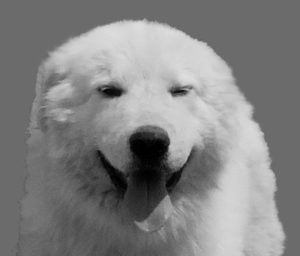Skull

Of great width with lateral sides slightly bulging. In profile also convex. The upper longitudinal axes of the skull and muzzle are slightly divergent, which makes the profile of the head slightly convex. The superciliary arches are moderately marked. The mediofrontal furrow line is slightly marked. The occipital crest is only just visible.
As already mentioned above, the quantification of the width of the skull is missing in the Standard. It is evident that it must be wide, but how much is it?
The 1958 Standard gives us the precise indication about its size. In it we can read: “the bizygomatic width of the skull must be slightly more than half the total length of the head” so, knowing that also the length of the skull is slightly more than half the total length of the head, we can safely say that the skull of the Maremma and Abruzzes Sheepdog is almost as wide as long.
When we talk about the sidewalls of the skull, we must consider together the temples, the cheekbones, the masseter region and the ears, and because we can talk about their profile, we must consider more the muscles of these sub-regions ratherthan their bone anatomical bases. The slightly convex profile of the sidewalls of the skull implies that above the temporal muscle, all the earphones and the masseter must have a development that protrudes slightly outside the lateral edge of the forehead. But the development of these muscles should not be excessive; therefore, the convexity of the profile should not be exaggerated. The reason is that the chewing muscles develop to the detriment of the length of the whole head. It is not by chance, that we find an important development of the masticatory muscles in short faced breeds.
The upper profile of the skull must also be convex both from a front view and from lateral. This convexity must be due to a large circumference arc, clean and without any interruptions or edges. The convexity of the two profiles of the skull (lateral and frontal) certainly implies also a convex cranial box, that is a necessary condition, so that, there is no exaggerated development of the masticatory muscles. In addition, here we connect to the slightly convex profile of the sidewalls of the skull mentioned above.
Considering the lateral profile, instead, in order to have a slightly convex profile, a decisive role is played by the moderately outlined superciliary arches and, above all, by the slightly diverging course of the cranio-facial axes. Then we must say NO to the flat or domed skull upper profiles. The first is a more serious fault because it is a typical characteristic of the cousins Hungarian Kuvasz and Slovakian Chuvach that have a flat top of their head.
It must be clearly stated that the slight divergence between the upper axes of the skull and the muzzle is of fundamental importance; it is the basic type note for the Maremma and Abruzzes Sheepdog. Especially the slight upper axial divergence of the head define the position and shape of the eye, the consistency of the stop and the course of the side axes of the foreface. This is why no value can compensate the incorrect slight divergence of the cranio-facial axes in a dog of our breed. On this point, I would make a recommendation: if the slight divergence is a great value we must not think that a greater divergence constitutes a greater value; the breed expression would be conspicuously compromised as inevitably the stop would tend to disappear altogether, the eyes would tend to an ultra-lateral position and the muzzle would become pointy. If coffee with one sugar cube is good, it does not become very good with five or six cubes. Certainly, the convergence of the cranio-facial axes is a much more serious fault; in fact, it is a disqualifying fault.
The superciliary arches must be poorly developed but visible and detectable. This clarification is very important since we often see heads with superciliary arches very depressed because of the exaggerated development of the temporal muscle, which invades arches and prevents their appropriate relief.
The exaggerated development of the superciliary arches, on the contrary, is always accompanied by an over-pronounced medium-frontal furrow that leads to an excessively sharp and annoying division of the front. The ideal metopic suture of the Maremma and Abruzzes Sheepdog must be slightly marked in the anterior part of the frontal region to become more and more backwards (abortionally) until it disappears completely in the middle of the skull yet. We need to be very careful with this point because distinct furrow is a characteristic of the Hungarian Kuvasz.
The head is connected to the neck, harmoniously continuing the arch of the upper profile of the skull, without depression or other interruptions on the back of the head. This continuous profile is possible if the occipital crest is just barely visible. In this regard, it should be noted that the anatomical bone base of the occipital apophysis is always very protruding in all breeds including ours. On live animals, what changes according to the type of head is the greater or lesser visual perception of the occipital apophysis from the outside due to the minor or greater development of the overlying musculature. At the sides of the occipital crest, in fact, are the deep temporal pits that are filled by the temporal muscle and overlying bands of other muscles, including those important for the strength of the neck and for the rigidity of the top line. So it is easy to understand the importance of a slightly prominent occipital crest since it is an indication of very developed muscles and ligaments. In contrast, the occipital crest which is protruded is a clear symptom of weak and poorly developed muscle mass, with the consequence of a visible neck jump also in a longhaired breed like ours. A Maremma and Abruzzes Sheepdog with a thin nape will never have a strong and muscular neck.

